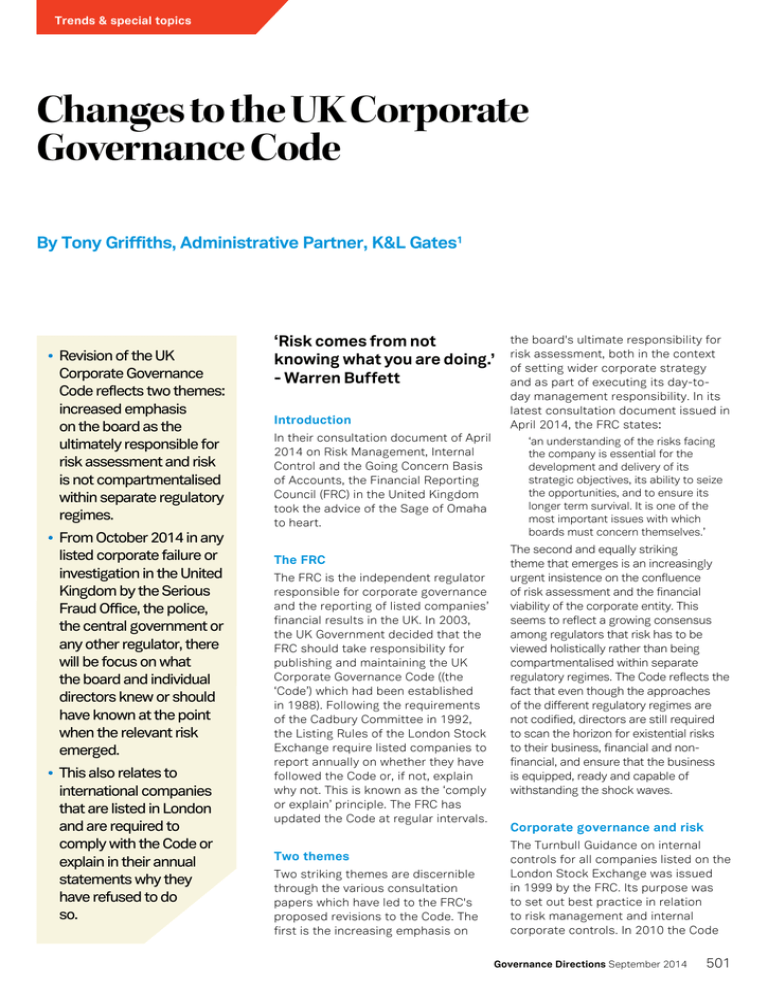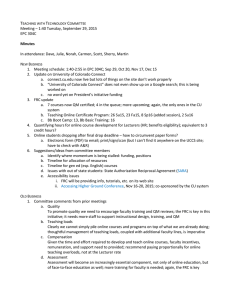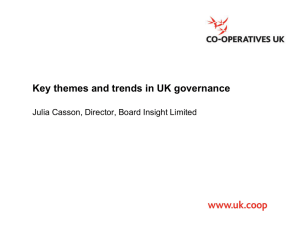Changes to the UK Corporate Governance Code ‘Risk comes from not
advertisement

Trends & special topics Changes to the UK Corporate Governance Code By Tony Griffiths, Administrative Partner, K&L Gates1 • Revision of the UK Corporate Governance Code reflects two themes: increased emphasis on the board as the ultimately responsible for risk assessment and risk is not compartmentalised within separate regulatory regimes. • From October 2014 in any listed corporate failure or investigation in the United Kingdom by the Serious Fraud Office, the police, the central government or any other regulator, there will be focus on what the board and individual directors knew or should have known at the point when the relevant risk emerged. • This also relates to international companies that are listed in London and are required to comply with the Code or explain in their annual statements why they have refused to do so. ‘Risk comes from not knowing what you are doing.’ - Warren Buffett Introduction In their consultation document of April 2014 on Risk Management, Internal Control and the Going Concern Basis of Accounts, the Financial Reporting Council (FRC) in the United Kingdom took the advice of the Sage of Omaha to heart. The FRC The FRC is the independent regulator responsible for corporate governance and the reporting of listed companies’ financial results in the UK. In 2003, the UK Government decided that the FRC should take responsibility for publishing and maintaining the UK Corporate Governance Code ((the ‘Code’) which had been established in 1988). Following the requirements of the Cadbury Committee in 1992, the Listing Rules of the London Stock Exchange require listed companies to report annually on whether they have followed the Code or, if not, explain why not. This is known as the ‘comply or explain’ principle. The FRC has updated the Code at regular intervals. Two themes Two striking themes are discernible through the various consultation papers which have led to the FRC's proposed revisions to the Code. The first is the increasing emphasis on the board's ultimate responsibility for risk assessment, both in the context of setting wider corporate strategy and as part of executing its day-today management responsibility. In its latest consultation document issued in April 2014, the FRC states: ‘an understanding of the risks facing the company is essential for the development and delivery of its strategic objectives, its ability to seize the opportunities, and to ensure its longer term survival. It is one of the most important issues with which boards must concern themselves.’ The second and equally striking theme that emerges is an increasingly urgent insistence on the confluence of risk assessment and the financial viability of the corporate entity. This seems to reflect a growing consensus among regulators that risk has to be viewed holistically rather than being compartmentalised within separate regulatory regimes. The Code reflects the fact that even though the approaches of the different regulatory regimes are not codified, directors are still required to scan the horizon for existential risks to their business, financial and nonfinancial, and ensure that the business is equipped, ready and capable of withstanding the shock waves. Corporate governance and risk The Turnbull Guidance on internal controls for all companies listed on the London Stock Exchange was issued in 1999 by the FRC. Its purpose was to set out best practice in relation to risk management and internal corporate controls. In 2010 the Code Governance Directions September 2014 501 Trends & special topics The gradual emergence of the inextricable link between risk assessment, corporate governance and financial stability and reporting is likely to continue to manifest itself in corporate governance best practice in the UK was updated and it was made clear that in addition to being responsible for ensuring a sound risk management and internal control system, boards should determine the nature and extent of the principal risks that they are willing to take in order to achieve the company’s strategic objectives. In its report of 2012, the Sharman Inquiry into going concern and liquidity risks concluded that the assessment of whether a company remained a going concern should be broadly based rather than focusing exclusively on a strict interpretation of an accounting approach. The FRC had come to a similar conclusion in its own 2011 report on ‘Boards and Risk’. The combination of the recommendations of Sharman and ‘Boards and Risk’ might be summarised as follows: • The board of directors establishes the risk culture of the company. • Risk management and internal controls must be integrated into the company’s standard management processes and should not be viewed as a separate ‘compliance exercise’. • The board must make an assessment of the principal risks to the company’s business model and its ability to deliver its strategy including solvency and liquidity risks. In making the assessment, the board should consider the likelihood and impact of those risks materialising in the short and longer term. • Having identified the risks, the board should agree on how they will be managed and mitigated. 502 Notwithstanding the apparent consensus between Sharman and ‘Boards and Risk’, it was not until October 2013 that the FRC issued a consultation document which suggested proposed amendments to the Code to capture many of the suggestions emanating from the two reports. However, it appeared to go further than either of the earlier reports. It suggested an amendment which would have had the effect of establishing a link between disclosures which the company makes on principal risks, which it is required to make in its Annual Strategic Report, and those that it makes on its going concern status in its financial statements. The proposed wording read as follows: ‘The Board should carry out a robust assessment of the principal risks facing the company including those that would threaten its solvency or liquidity. In the Annual Report, the directors should confirm that they have carried out such an assessment and how the principal risks are being managed or mitigated. They should indicate which, if any, are material uncertainties in relation to the company’s ability to continue to adopt the going concern basis of accounting.’ In a further consultation document in April 2014, the FRC suggestion appeared to make the linkage of risk and financial viability of the company even clearer. It required the directors to declare whether, taking account of the company’s current financial position and principal risks, they have a reasonable expectation that the company will be able to continue in operation and meet its liabilities as they fall due, drawing attention to any qualifications or assumptions as necessary. Specifically, directors should state this, specifying the period covered by their statement and why they consider it appropriate. The FRC indicates that the period covered by the directors’ statement should be significantly longer than twelve months. Suggested practical significance In practical terms, this means that, as of October 2014 (which is the date specified in the April 2014 consultation document for the start date for the new guidance), in any listed corporate failure or investigation in the United Kingdom by the Serious Fraud Office, the police, the central government or any other regulator, the authorities or insolvency practitioners will carefully examine what steps the board took to comply with FRC requirements as a matter of evidence. What is more, this will be done with the benefit of 2020 hindsight. In particular, there will be a focus on what the board and individual directors knew or should have known at the point when the relevant risk emerged. The linkage of risk assessment, corporate governance requirements, going concerns certification or certification of financial viability over a longer period of time, could lead to wrongful trading type arguments in the context of overall risk assessment. Under UK insolvency laws, directors can become personally liable for insolvent company liabilities if they know or should have known that a company was unlikely to avoid insolvency but they continued to permit the company to trade. The prospect of similar arguments being used in the context of civil or criminal proceedings relating to risk assessment procedures and what directors did or should have known seems to have become more likely with the new FRC suggestions. Importantly, all of this also relates to international companies that are listed in London and are required to comply with the Code or explain in their annual statements why they have refused to do so. The future The gradual emergence of the inextricable link between risk assessment, corporate governance and financial stability and reporting is likely to continue to manifest itself in corporate governance best practice in the UK. The linkage between the concept was a fundamental premise of the Sharman Report in particular. Moreover, even prior to issuing its consultation documents in October 2013 and April 2014, the FRC encouraged companies to consider and abide by the principles outlined in the Sharman Report. The direction of travel of corporate governance regulations seems pretty clear and once again the responsibility for risk assessment falls squarely on the shoulders of the directors. In a business environment which is increasingly defined by globalisation, the days of the one issue, one jurisdiction crisis appear to have gone. A single issue can morph and evolve, either domestically or internationally to leave the organisation having to deal with different regulations and different enforcement agencies on many fronts. Multiple regulatory and enforcement agencies raising multiple issues in multiple jurisdictions very often in relation to a single set of facts, is an increasingly common feature of crisis management. The approach of the Code is to emphasise the responsibility of directors to anticipate and assess not only the risks to their business but also to work out the interplay between the risks that they have identified and the mitigation required to ensure that any crisis does not prove fatal. In reviewing current regulatory and corporate governance approaches, we cannot help but hear the echo of the prophetic words of Peter Drucker in Managing in Turbulent Times (1980) that ‘the first priority of management (the directors) is to ensure the survival of the business.’ Tony Griffiths can be contacted on tony.griffiths@klgates.com Notes 1 Tony Griffiths is the Administrative Partner of the K&L Gates London office and a member of the firm’s Restructuring & Insolvency practice group. Governance Directions September 2014 503





